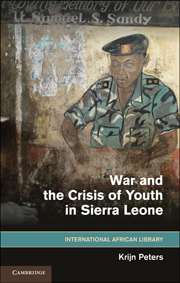Book contents
- Frontmatter
- Contents
- Acknowledgements
- Abbreviations
- Introduction
- 1 Voices from the Battlefield: Ex-Combatants' Views on Root Causes of the War and Their Reasons for Participation
- 2 The Socio-Economic Crisis of Rural Youth
- 3 Conflict in Sierra Leone and Recruits to the War
- 4 The World of the RUF
- 5 Malfunctions and Atrocities
- 6 Cultivating Peace: RUF Ex-Combatants' Involvement in Post-War Agricultural Projects
- 7 Footpaths to Reintegration? Agrarian Solutions for the Reintegration of Ex-Combatants
- 8 Conclusion: The RUF as a Rural Underclass Project
- Epilogue
- Annex I A Chronology
- Annex II Overview: Interviewed Ex-RUF Combatants
- References
- Index
- THE INTERNATIONAL AFRICAN LIBRARY
3 - Conflict in Sierra Leone and Recruits to the War
Published online by Cambridge University Press: 03 May 2011
- Frontmatter
- Contents
- Acknowledgements
- Abbreviations
- Introduction
- 1 Voices from the Battlefield: Ex-Combatants' Views on Root Causes of the War and Their Reasons for Participation
- 2 The Socio-Economic Crisis of Rural Youth
- 3 Conflict in Sierra Leone and Recruits to the War
- 4 The World of the RUF
- 5 Malfunctions and Atrocities
- 6 Cultivating Peace: RUF Ex-Combatants' Involvement in Post-War Agricultural Projects
- 7 Footpaths to Reintegration? Agrarian Solutions for the Reintegration of Ex-Combatants
- 8 Conclusion: The RUF as a Rural Underclass Project
- Epilogue
- Annex I A Chronology
- Annex II Overview: Interviewed Ex-RUF Combatants
- References
- Index
- THE INTERNATIONAL AFRICAN LIBRARY
Summary
I now turn to an overview of the conflict. Some of these events are further illuminated by the personal memories and commentary of ex-combatants and civilians interviewed for this book. It will become clear that the armed conflict in Sierra Leone was a highly complex affair. It involved a series of armed groups, including the RUF, the army, army renegades and splinter factions, the civil defence forces (Kamajoisia, Kapras, Tamaboros), mercenaries (Gurkhas, EO, Sandline), foreign factions United Liberian Movement for Democracy (ULIMD) or armies (Guinean soldiers), and peace enforcers/keepers (ECOMOG, UNAMSIL, British troops). Regional and international interests (both political and economic) influenced the course of the conflict in overt and covert ways. Three successful coups and a democratic election punctuated more than a decade of struggle. Ceasefires were agreed upon and peace accords signed, only to be violated and broken again. Large parts of the population became displaced, returned, and resettled, but found themselves on the run once more when the war flared up again.
The Beginning
In March 1991 a small group of about a hundred guerrilla fighters entered eastern Sierra Leone from Liberia. For long it has been assumed that, in addition to Sierra Leoneans, the initial insurgents included Liberian fighters – Special Forces who were on loan from Charles Taylor's National Patriotic Front of Liberia (NPFL) – and a few mercenaries from Burkina Faso.
- Type
- Chapter
- Information
- War and the Crisis of Youth in Sierra Leone , pp. 62 - 79Publisher: Cambridge University PressPrint publication year: 2011

